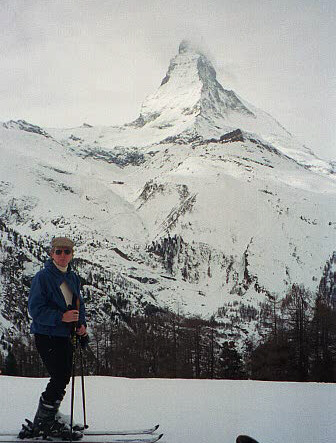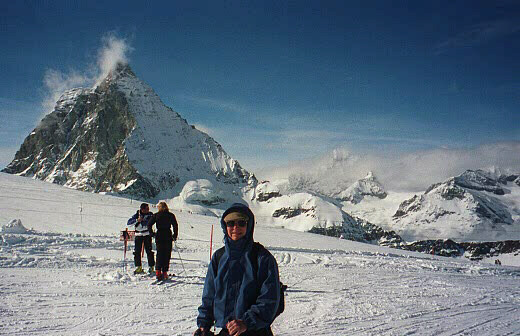Paul H. Carr
To Dad from Lilo, Age 10,
(Lilo is now a graphic designer for Goldman Sachs in New York City)
I had a "once in a lifetime" experience of staying at the highest
hotel in Europe, located on the 3100 m (or about 10,000 ft.) mountain peak,
Gornergrat, Switzerland. I reached Kulm hotel Tuesday, March 6th, 2001
by cog railway after walking about Zermattt, 1620m, with its many hotels
and Swiss Chalets with stone roofs. Zermatt, in the valley, offers an impressive
view of the 4478 m high Matterhorn, on the northern border with Italy.
My gasping for breath from walking up from the little stone Gornergrat
station to the hotel reminded me that the air is indeed very thin at 10,000
ft. The snow condition for skiing from Gornergrat down to Riffelberg (2582
m) was excellent packed powder.
Every morning at 745AM, the train would arrive from Zermatt with
a young man who carried a big brown bag of fresh bread over his shoulder
up to our hotel. This made a delicious breakfast for us at 800AM, with
many choices of cheese, fruit, yogurt, cold cuts, and granola.
Matterhorn 4478m

Dr. Jean Bonvin was from Sion, Switzerland in the Rhone River Valley,
which is lined with grape terraces facing the south. We had Swiss
Vallais wine with our dinner every evening. One of M.D.s had done his residency
at the Beverly, MA Hospital. They spoke English with me, but French among
themselves and James.
On Thursday we had a snowstorm with 60-mph wind gusts. James and I spent time talking to the German and Italian Scientists who operate the two telescopes on top of the Kulm hotel. These telescopes operate best in the winter when the water content of the atmosphere is very low. (My sinuses also gave me the same message. The first day they were uncomfortably dry and then I ended up getting a cold and a very runny nose.) Martin Druell, age 26, is working on a Ph.D. at the University of Koeln, Germany. He spent one and one-half hours showing us the operation of the sub-millimeter wave KOSMA telescope, which has superconducting mixers and acoustic-optical bragg cell spectrum analyzers for identifying CO in our Milky Way Galaxy. My comparing his results with theoretical predications made at Boston University, he hopes to contribute to our knowledge of star formation.
http://www.ph1.uni-koeln.de/~bruell
I was gratified that the research on microwave acoustics I did in the 1960s is being used to expand our knowledge of the universe.
Paolo Persi described the operation of the Italian TIRGO telescope described on
http://tirgo.unibe.ch
(This web site has a spectacular picture)
The infrared radiation is detected with a SiAs on Silicon 128x128 array
made by Rockwell International (now part of Boeing), which is sensitive
from 5 to 28 microns, and must be cooled by liquid helium. Dewars of this
refrigerant must be brought up the mountain by cog-railway. The superconducting
detectors used by the Germans no not require this as they have their own
closed cycle refrigerator. The infrared radiation detected by this telescope
is enabling scientists to view planet formation from galactic dust. Cousin
James spoke Italian with Paolo Persi, but he was fortunately able to speak
English with me.
Matterhorn 4478m

Paul
On Thursday, the Swiss plowed paths through
about a foot of powdery snow with Honda snow blowers. We had an impressive
view of the Matterhorn as we skied down to Riffelberg, 2582m. We then took
the cog railway down to
Zermatt, 1620 m, and then a series of trams up to Furi, Trockener Steg,
and finally to the top of the Klein Matterhorn, 3820 m. This offered a
spectacular view of the Italian and French Alps, towered by Mt. Blanc.
The skiing down to Testa Grigia, 3479m, in Italy was excellent. Cousin
James had hope to have some excellent Italian spaghetti here, but the line
was too long. We therefore skied down to Trockener Steg, 2939 m. The Matterhorn
towered magnificently above us as we were now the closest to it. The skiing
down to Furgg, 2432m, was the steepest, with lots of moguls. My new Rosingnol
parabolic skies, with length equal to my 5 ft 7 inch height, served me
well. Cousin James had a harder time with his 12-year-old longer skies.
At Furgg, we waited in line for about one-half hour to take the tram back
down to Zermatt. The ski trail down to Zermatt was closed due to the danger
of avalanches. From the tram, we could see avalanches of newly fallen snow
that had come down over the 15-ft wide ski trail. The Swiss had used explosives
to trigger some of the avalanches. This is of course safer that having
them triggered by skiers.
We took the cog railway back to our hotel at Gornergrat. As I
climbed back to our hotel from the train station in Gornergrat in my heavy
Lange ski boots, at 6 PM, I found self still panting for breath, even though
I
had had 3 days to acclimate to the 10,000 ft altitude. I found
my self meditating on Psalm 121, one of my father's favorites:
"I will lift mine eyes unto the hills from whence commeth my help.
My help commeth from the Lord, who has made heaven and earth."
The magnificent scenery from the 10,000-ft high mountain peak of Gornergrat did bring me closer to heaven. It must be the divine within us that causes us to find such wonder and majesty in snow covered mountaintops. The ancient Greeks believed their gods lived on Mt Olympus. The science studied by astronomers on their mountaintops had its beginning in early Greek natural philosophy.
On Saturday, March 10th, we returned Givrins, a small farming hamlet
above Nyon on the Lake of Geneva, where James lives with his wife Helena.
James took me cross country skiing near La Givrine in the Jura Mountains
about 600 meters above Givrins. I was invigorated by skiing among fir trees
covered with beautiful snow. We overlooked LES PILES, a downhill ski area
in France. We skied close to a stone barn for milking cows grazing in the
alpine summer meadows. While taking the winding road down the Jura mountains,
I took pictures of the Lake of Geneva with
Swiss chalets in the foreground and the French Alps on the horizon.
James and Helena's daughter, Karin, took me for an informative walking
tour of Old Geneva. The Jet d' eau near the flag lined bridge of Mt. Blank
is an impressive symbol of this historic city. The successful revolution
in 1602, which
gained Geneva's independence from France, established Geneva as a haven
for creative people like Jean Jacques Rousseau, whose island we saw, and
Calvin, whose magnificent cathedral was near her apartment. Our visit
to the Russian Orthadox Church with its gold plated steeples, icons,
candles, and stained glass windows was heavenly. 20 Rue Sturm nearby was
a very impressive apartment building. Karin's apartment, built in 1750
and located close to the University of Geneva where she studies, has an
ambiance, which enriches her studies of economic development in Kenya,
Tanzania, and Rwanda.
On Sunday morning, March 11, James took me to see the last day of the
Auto Salon, which started on March 1st. This large auto show was attended
by about 700,000 people, and caused major traffic jams. The population
of Switzerland is about 7 million people. Needless to say, auto shows are
very popular in this part of Europe especially among young people.
http://www.salon-auto.ch
On Monday, March 12, I visited Prof Helmut Reich at Regina Mundi, which is part of the University of Freiburg, Switzerland. I had met Helmut at Institute of Religion in an Age of Science Conferences off Star Island, Portsmouth, NH. He was kind enough to give me copies of sections of his new book on Relational and Contextual Reasoning.